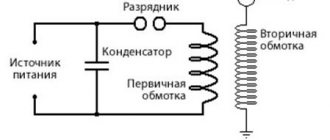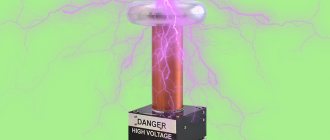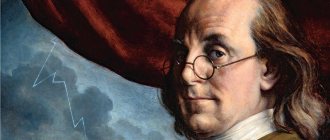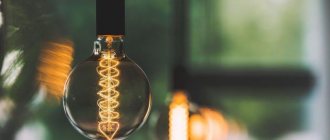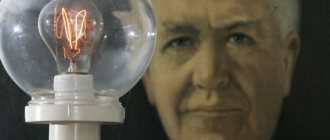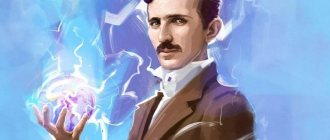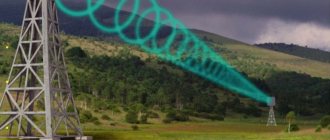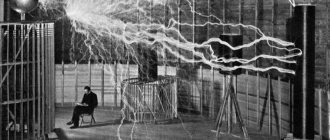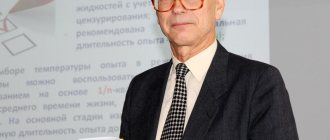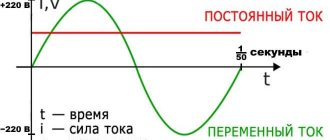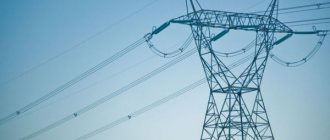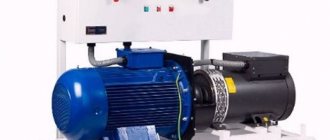Wires have completely enslaved humanity. Modern cities are drowning in a web of cables - on the ground, underground and in the air, endless kilometers of copper snakes wrapped in rubber stretch. If you go outside and raise your head up, you will see ornate wire connections between power poles, and a tram with a raised pantograph will pass by. The madness of connecting cables only intensifies in the offices of large organizations - standard distribution panels here look like alien creatures with curling tentacles. You don’t even have to look far for an example - you just need to look under the computer desk, where there is a surge protector with connected speaker adapters, chargers for cell phones and cameras, power cords for the monitor and system unit...
Meanwhile, technology has been following the path of miniaturization for several years, abandoning interface cables and switching to mobile power sources such as batteries. Moreover, manufacturers have advanced quite far in this area - wireless networks are very popular in offices and ordinary homes, numerous computer peripherals have switched to radio frequency interfaces.
In general, the number of wires decreases every year. The only thing that remains unchanged is the annoying power cord. No matter how advanced a cell phone is, it will have to be charged using a wired adapter. No matter how long a mouse runs on two AA batteries, someday they will have to be replaced (and, as a rule, they run out at the most crucial moment). And more demanding equipment like televisions are not yet able to get rid of power cords. We have all become accustomed to this long ago and take it for granted, but this cannot go on forever! Fortunately, scientists understand the problem and are working tirelessly to create wireless energy transfer technologies.
True, if you delve a little into history, you can discover an interesting fact: the “wire problem” would not have existed long ago if people of a bygone era had shown a little less skepticism and had not spared money on the research of one single person. Yes, yes, we are talking about the greatest Serbian-American physicist, engineer, inventor in the fields of electronics and radio engineering - Nikola Tesla. The work of this scientist was not appreciated at the time (and all the results of his work and the secrets of his ingenious inventions disappeared after Tesla’s death under unexplained circumstances), and now contemporaries have to restore the technologies developed more than a hundred years ago bit by bit. Some advances and even working devices already exist, but their popularization and implementation will still take a lot of time - modern inventions for the mass market look too clumsy... But let's start from the beginning.
Lord of Lightning, Black Mage, Lord of Electricity
Tesla's mythical fame comes from two sources. Firstly, there was a grandiose business battle between the Edison companies (various direct current devices) and Westinghouse (alternating current). We can say that at the turn of the 19th and 20th centuries the modern capitalist market was born, and it was in the USA. All methods of struggle for economic survival were used - right down to physical tricks and performances in front of the public and loud newspaper headlines.
Tesla, apparently, was a very dreamy man, with immense intuition and rich imagination. So rich that, reading excerpts from his numerous press conferences and interviews that he gave to attract new flows of finance, one can imagine Tesla as a kind of semi-mythical character and techno-magician. However, a distinctive feature of almost all of his public appearances is understatement.
Photo: Mary Evans Picture Library/Mary Evans Picture Library/East News
For example, in 1899–1900, a research expedition was carried out in Colorado Springs - this region was famous for constant and frequent thunderstorms. Tesla and his team of engineers studied lightning and built the first experimental installations of enormous size to produce powerful electrical discharges simulating lightning (spark discharge in the atmosphere). It was then that Tesla’s reputation began to take shape among the US population far from science as the “lord of lightning”, “black magician of electricity”, etc. Having developed the design of a large high-frequency emitter , Tesla was actually able to obtain voltages from 12 to 20 million volts (according to various sources) and currents of thousands of amperes. This truly was a design and engineering achievement. Along the way, Tesla confirmed the promising use of several remarkable properties of strong electrostatic fields: fog deposition, cleaning surfaces from rust, dirt, and paint. That is, the million-volt circuits developed by Tesla really opened up new ways to study microwave (high-frequency) currents.
However, upon arrival from Colorado to New York, an extensive article was conceived for Century magazine, devoted to the results of the Colorado experiments. As often comes up when studying the biography of Tesla and his works, there were problems with the article. It looked more like a philosophical treatise or a science fiction novel than a scientific report on new results. But it must be said that many science fiction writers of the early 20th century predicted future technologies in their novels.
The second reason for Tesla's fame and popularity is a fundamental social phenomenon. During the period between the world wars, the United States had already become the most powerful world power. But everyone treated the Americans like yesterday’s colony. This gave rise to a strong inferiority complex. It was especially bad with science. In Europe, science developed over many centuries, even millennia. In terms of engineering work, the Americans did simply miracles in the fruitful conditions of a rapidly developing market, but for scientific success it was necessary to develop their own scientific school, traditions and experience. All this required considerable time, so politicians and strategists sought to get scientists from other countries. This required authority, which they tried to gain as quickly as possible - for this purpose, the (often biased) achievements of their own scientists and engineers were overly promoted. It is no coincidence that many historians of physics note numerous attempts to nominate Tesla and Edison as Nobel laureates, as well as serious pressure on the recognition of Pluto as a planet, because the discovery was made by the American astronomer Percival Lowell.
Youth
Nikola Tesla was born in the village of Smiljani on July 10, 1856 in the family of the Serbian Orthodox priest Milutin Tesla. Today Smiljany is located on the territory of Croatia, but at that time this place was located in imperial Austria-Hungary.
In 1862, Nikola’s father was promoted to rank, and Tesla’s family moved to the city of Gospić, located six kilometers from Smilyan. In his new place, Nikola graduated from primary school and a three-year lower real gymnasium. In the fall of 1870, he entered the Higher Real School, located in the city of Karlovac.
A curious episode dates back to the first period of Nikola Tesla’s life in Gospić, which probably determined Nikola’s craving for electricity. They say that at the age of ten, the future scientist stroked a fluffy black cat while sitting on the porch of the house. Nikola noticed that sparks were jumping between his fingers and the cat’s fur, clearly visible in the evening. The boy asked his father, who was nearby, about the nature of these sparks. Tesla Sr. replied that sparks are most likely “relatives” of lightning. The father’s answer forever sank into the impressionable boy’s soul, clearly showing him that electricity (which Nikola knew nothing about at that time) can be both “tame” like a domestic animal and “wild” like thunderbolt.
In 1873, an event occurred that finally turned Nikola Tesla’s whole life upside down. Having received a certificate of maturity in July 1873, Nikola decides to return to her parents. There was a cholera epidemic in Gospić, and Nikola fell ill. By this time, the young man was quite ripe for making a responsible decision: to follow not in his father’s footsteps, but to study to become an engineer. In Karlovac, Nikola studied mathematics and physics a lot. He was especially impressed by Professor Martin Sekulic, who taught physics. This professor was demonstrating his own invention in action - a light bulb covered with tin foil, which rotated rapidly while connected to a static machine. “It is impossible to convey the feeling that I experienced while looking at the demonstration of this amazing phenomenon. Every show echoed in my mind,” the great Serb later recalled.
It was Nikola’s reluctance to become a priest that caused a rather serious dispute between father and son. Some sources even connect Nikola’s illness with Milutin’s sharp rejection of his son’s decision; allegedly, Nikola was so impressed that he fell ill from great grief. In fact, everything was much more prosaic, which does not negate the seriousness of Nikola’s situation.
Tesla’s body, which had recently suffered a fever in the Karlowitz swamps, was weakened, so Nikola lay in bed for a very long time. The doctors even assumed the worst, but then something really strange happened. Waking up one day of a long illness, Nikola turned to his father with an urgent request to allow him to enter school. Milutin had no choice but to give an affirmative answer. And a miracle happened - Nikola recovered in just a few days.
However, the terrible disease did not pass without a trace. Firstly, Tesla developed a manic fear of catching some kind of infection. Subsequently, he began to wash his hands frequently, and if during lunch he noticed a fly on the table, he immediately placed a new order for the waiter. Secondly, Nikola began to have visions in the form of flashes of light. “Strong flashes of light hid pictures of real objects and simply replaced my thoughts,” Tesla writes in his diary.
But these flashes often appeared for a reason, but accompanied by a vision of future inventions. Tesla had an unusual gift - he could imagine any device or device in his mind, mentally test it, and then bring it into reality completely ready for use. In this regard, Nikola was strikingly different from another famous inventor - Thomas Edison, with whom Tesla would later be brought together by fate. Edison spent a lot of time on experiments, on finalizing inventions, while Tesla carried out tests in his head, the work of which would be the envy of any modern computer.
First or not? Who cares!
Let's try to evaluate the works of Nikola Tesla as objectively as possible and understand the important role he played in the second world industrial revolution of the early 20th century.
Conventionally, Tesla’s working life can be divided into two periods: before the fire in his laboratory in New York in March 1895 and after.
Before this event, Tesla's inventions can confidently be called extremely effective, useful and ingenious. Many are reliably confirmed by patents and articles. It is very important here to try to imagine the state of the scientific and engineering society of that time. In the 19th century, the discoveries of Oersted, Ampere, Ohm, Faraday, Maxwell and other scientists led many to a clear understanding that electromagnetism was the future. A huge number of brilliant minds around the world have been busy exploring the applications of electrical and magnetic phenomena. If in one country one person achieved some kind of technical discovery, then in another part of the globe at the same time another person could easily construct something similar. Therefore, debates about who was first continue to this day. Although why not just determine that several people were first? Does this detract from their merits?
Photo: East News
This happened many times later with the legacy of Nikola Tesla. For example, it is reliably known that in 1891 he demonstrated in practice the use of radio communications using a transmitting device with a resonance transformer . This is confirmed by the famous radio-controlled model of Tesla's boat. It’s hard to imagine, but back at the end of the 19th century, humanity saw the remote control of a boat model. Of course, there is debate about who came first - Tesla or the Russian physicist Alexander Popov, who created radio around the same time.
“ray tubes” in the 1890s , powered by resonant transformers of his own design and emitting, as they are now called, X-rays. The question of the priority of such an outstanding discovery, for which Wilhelm Roentgen received the Nobel Prize in 1901, is still being discussed. However, Tesla himself did not claim the discovery.
In addition, Tesla, being a proponent of the theory of the existence of an electrical ethereal medium, explored the possibility of creating channels in the ethereal medium through which huge electrical impulses could be transmitted. By all indications, this idea was ahead of its time by almost half a century. Now this phenomenon is called a plasma cord. However, there is no evidence of any clear and substantiated result of Tesla, only about the idea and trial experiments.
The same applies to well-known speculations about knowledge of ball lightning . There are many references at the level of conversations and interviews. According to Tesla himself, he was not interested in this phenomenon, which he understood, since it was a side attribute in the creation of powerful spark discharges, with which Tesla hoped to transmit electricity wirelessly. However, the phenomenon has not been clearly explained either then or now.
October 12, 1887 is an important date in Tesla's career. On this day, he published a rigorous scientific description of the essence of the phenomenon of a rotating magnetic field . This important discovery contributed to the fact that subsequently the unit of measurement of magnetic induction in the international system of units SI was named in honor of Nikola Tesla.
While working for Westinghouse, Tesla patented many different applications for a wide variety of polyphase alternating current systems. Before the invention of the so-called asynchronous motor, alternating current was not widely used, since it could not be used in previously existing electric motors operating on direct current.
Charging for the tail
Wireless power transmission has already been used in some areas. Thus, most electric toothbrushes have long used the inductive bonding method for obvious reasons - any contact with water can lead to a short circuit, and an apartment that burns out due to the fault of a toothbrush is unlikely to add popularity to manufacturers. The design is moderately simple, like everything ingenious: one magnetic coil is placed at the bottom of the brush, and a second one is located in the stand. When the brush is installed in the stand, the magnetic fields of the coils begin to interact and charge the built-in batteries.
| Is Marin Soljachich destined to become the Nikola Tesla of the 21st century? Let's hope he manages to commercialize the WiTricity technology, we're really tired of wires. |
CES 2009
at the beginning of 2009, it was full of solutions based on inductive coupling.
Numerous manufacturers have decided to simplify the process of connecting to chargers - that is, we are gradually moving into the wireless era. An excellent example of a new concept can be considered the developments of the company Powermat
, which presented a whole line of devices for wireless charging of various equipment.
Powermat offers everyone who wants to buy an induction mat and receivers for the most popular devices - a docking station for Apple iPod
, housings for smartphones, plugs for laptops and digital cameras. After connecting the receiver, all that remains is to place the charging device on top of the mat - and that’s it, charging has begun. Of course, you won’t be able to get rid of connecting the Powermats themselves to power outlets, but at least the number of wires will be reduced by three.
Another discovery at CES 2009 was eCoupled
, created by
Fulton Innovation
. Already this year, various working tools (drills, screwdrivers and even flashlights) with contactless docking stations will appear on the market. All this, of course, is good and healthy, but inductive coupling cannot be called an ideal technology for the near future. Yes, users of a wide variety of mobile equipment will get rid of the need to connect a wire to the devices themselves, will be able to put all their players and cameras on one single mat at once and start charging, getting rid of an armful of wires - but heaven on Earth is still far away. I would like to go into the apartment, throw the phone on the sofa, put the bag with the camera on the floor and open the laptop on the table, automatically starting charging - without any wires or additional devices. But, alas, for now we can only wait for the arrival of more advanced technology that can increase the range of wireless chargers.
| Inductive wireless energy transmitters will be able to work through the wall; all that remains is to reduce the diameter of the coils and develop standards. |
According to the team from the Massachusetts Institute of Technology (MIT), this will happen very soon. A group of scientists led by physics professor Marin Solyacic is working there on research in the field of inductive resonance coupling. They say that once Mr. Soljacic woke up at night because his cell phone was dead and began to send annoying signals, and he was overcome by insomnia. All night, Marin irritably thought about a wireless charger that would start charging his phone as soon as he entered the house, and the next morning he began developing such a device. Based on the inductive resonance coupling method, of course.
“The easiest way to explain this method is this,” says Mr. Soljacic. —Imagine a row of wine glasses filled to different levels (so they all vibrate at different frequencies). If the singer sets a note that matches the frequency of one of the glasses, it absorbs the sound and begins to vibrate. Everyone else remains motionless. In the same way, the magnetic field binds and begins to transfer energy only to the magnetic field at the same frequency.”
Using the resonance method, Soljacic's team assembled a setup with two coils tuned to the same frequency, two meters apart. One of the coils was connected to an energy source, it began to transfer energy to the second and easily “lit” a 60-watt lamp without the use of wires! Scientists have already proposed the most effective combination within the framework of the method used: two copper coils with a diameter of 60 cm and a magnetic field at a frequency of 10 MHz can provide wireless energy transmission over a distance of up to 2 meters. The technology was called WiTricity
(from two English words - “Wireless” and “Electricity”). Well, all that remains is to bring the technology to fruition - at the moment the team is already looking for a suitable material to reduce the diameter of the coils and increase efficiency.
| Fulton eCoupled technology will allow you to charge mobile equipment directly in the car, placing it in a designated place. | Powermats and corresponding technology receivers will sell for $25-30, quite reasonable for a promising future technology. |
| War of Currents |
This is rarely written about in history books, but at the dawn of the era of electricity, a real “war of currents” took place with the participation of the best minds of the time and considerable financial investments. The so-called “king of inventors” Thomas Edison entered into a confrontation with Nikola Tesla over the use of direct or alternating current.
From the very beginning of his career, Nikola Tesla advocated the use of alternating current in generators and electric motors. The inventor had sufficient mathematical knowledge and could confirm all the advantages of using alternating current. However, the theorist and experimenter Thomas Edison had already managed to “take over America” with the help of generators and lamps based on direct current - his technologies worked at low load and, in general, suited everyone. Of course, the American inventor did not want to stand aside and lose his fame, especially since “some Serbian immigrant” challenged him. Edison did everything he could to discredit Nikola Tesla's name and disgrace his inventions: he spread information about his frequent fatal experiments with alternating current, made harsh statements, publicly electrocuted animals, and even secretly paid Harold Brown to create the first electric chair in history.
Apparently, Nikola Tesla, with his calm character, did not pay much attention to Edison’s antics. Perhaps this is what led the creators of the huge Niagara Falls hydroelectric power station to choose Tesla's alternating current as the only type of energy generated and transmitted. When Niagara Falls successfully transmitted electricity from hydroelectric generators to the industrial area of Buffalo in November 1896, Thomas Edison finally realized his failure. However, the two inventors remained blood enemies until the end of their lives - they refused to split the Nobel Prize offered to them for their joint contribution to the development of electricity, and later Nikola Tesla refused the Edison Medal for his contribution to science.
How a Russian engineer gave Tesla a hint
In 1895, the Westinghouse company launched the world's first hydroelectric power station, the Niagara Hydroelectric Power Station. I don’t see any problem in admitting Tesla’s mistakes. Today, a three-phase current system , which was invented in 1890 by the Russian engineer, one of the founders of electrical engineering, Mikhail Osipovich Dolivo-Dobrovolsky . Tesla considered the two-phase system to be the most economical.
At the 1891 exhibition in Frankfurt am Main, Tesla became acquainted with Dolivo-Dobrovolsky's invention and, realizing the undeniable advantages of the three-phase system, went back to the USA to remake the system of the Niagara Hydroelectric Power Station. Dolivo-Dobrovolsky is unfairly forgotten against the backdrop of Tesla’s loud, semi-mythical glory, so I think it’s important to mention him. But this fact cannot be considered humiliating towards Tesla; this is an absolutely normal path for the development of human inventions. Thus, Tesla’s merits can confidently be attributed to the fairly rapid assimilation of the European concept of three-phase current transmission and three-phase electric motors and the construction of these systems in the USA.
Since 1889, Nikola Tesla began researching high frequency currents and high voltages. As we said at the beginning, he invented the first samples of electromechanical high-frequency generators and a high-frequency transformer, thereby creating the prerequisites for the development of a new branch of electrical engineering - HF technology .
Photo: NIKOLA TESLA MUSEUM/Science Photo Library/East News
In the course of researching high-frequency currents, Tesla, of course, paid attention to safety issues. Subsequently, many researchers and engineers greatly benefited from Tesla's rich accumulated experience in this very important topic. While researching safety issues, Nikola Tesla had to experiment with his own body in order to better understand how alternating currents of various frequencies and amplitudes affect the human body. He was the first to formulate rules for working with RF currents, which are still used today. For example, Tesla was convinced by personal example that electric current with a frequency above 700 Hz flows painlessly over the surface of the body and does not harm tissues. In addition, the engineer developed the first electrical devices for medical research, which became popular throughout the world. Electrotherapy is still used today: for example, to cleanse pores, remove rashes, etc. Bacteria, as it turned out, quickly die under the influence of electricity, and Tesla was the first to discover that contaminated surfaces could be easily and simply cleaned in this way.
130 years ago, on March 10, 1891, an engineer patented a reliable method for generating currents, the “Method of Controlling Arc Lamps.” This invention was very useful in radio communications to eliminate interference from a noisy arc lamp.
Remote control boat
Proposed in: 1907
In 1898, during an electrical exhibition, Tesla demonstrated a (small) radio-controlled boat that he could maneuver over water. At the same time, he entertained the audience by creating the impression that the boat obeyed the voice commands of the audience. In reality, however, he controlled the boat using radio frequencies. He called this technology “telautomatics”.
For many of those present that day, it was a moment of pure magic. On the other hand, few saw it as a potential war machine. Tesla received a US patent for this on July 1, 1898.
About Tesla Tower
Since 1896, Tesla apparently decided that the main goal of his life should be the idea of wireless transmission of electricity to anywhere on the planet.
Having secured the financial support of the American industrialist John Morgan, the scientist built the huge Wardenclyffe Tower , which later became a symbol of the mythical side of Nikola Tesla's life. It was an experimental wireless transmission station built for worldwide telecommunications. Tesla had already proven that high-frequency signals could be transmitted wirelessly using Tesla coil transformers.
He obtained funding to build the tower by disguising it as a telecommunications tower. Further experiments in this constructed laboratory convinced him that it was possible to transmit electricity if the upper layers of the atmosphere were used. In the future, Tesla envisioned a network of towers spanning the entire globe, receiving remote wireless power from a central station.
As Tesla stated in an interview of those years, he discovered the basic principles and supposedly all that remains is to develop them commercially. Unfortunately or fortunately, Tesla's unbridled fantasies never saw the light of day. Firstly, almost all biographers confirm the fact that John Morgan was frightened when he learned about Tesla’s real plans for the tower and stopped funding the project in 1905. The industrialist (regardless of the final success of the project) was afraid that if electricity was free everywhere, the entire system of providing energy to the population and production, from hydrocarbons to hydroelectric power stations and thermal power plants subsequently, would collapse.
Tesla failed to find new investors - for reasons similar to Morgan. And the tower remained abandoned. By the way, this information is very important when considering the phenomenon of the Tunguska meteorite . By the time of his “fall,” the tower had been inactive for more than two years. This fact seriously contradicts theories that the Tunguska miracle is the work of Nikola Tesla.
The unfinished tower was demolished in 1917, at the height of the First World War, as it could serve, according to many historians of the time, for radio transmission of information by German signalmen.
Earthquake machine
Most of Tesla's experiments were amazing and dangerous. During another experiment, the scientist destroyed his laboratory and even caused an earthquake. And all this with the help of a device weighing about a kilogram called an oscillator oscillator.
Tesla's new invention created vibrations that could be tuned to the vibration frequency of any object, such as a building. A resonance was created, which led to the rapid destruction of the building and the formation of tremors.
Realizing the potential danger of his invention, the brilliant Serb stopped his experiments and destroyed the oscillator.
A modern jackhammer works on the principle of a Tesla resonator.
Is wireless energy transfer even possible?
Without detracting from the merits of Nikola Tesla in general, it can be assumed that he could not fully understand the nature of the phenomena in his experiments. Like any of the pioneers at the turn of the century, he did not have a sufficient scientific basis at his disposal.
For example, Tesla proposed creating a so-called standing wave of enormous length in the ground, using the Earth as a huge conductor. They say that for us the globe is extremely large, but for an electromagnetic wave it is just a conductor. And one cannot argue with this, but the problem with such a giant conductor is its heterogeneity: there are too many differences depending on the composition of the soil, humidity, etc. But one characteristic remains unchanged - high resistance. In addition, a lot of energy will be spent on rotating dipoles in polarizable substances, reversing the magnetization of domains, various kinds of “parasitic” radiation, etc. The heterogeneity of the Earth’s massif will inevitably distort the wave front beyond recognition, so the efficiency of such “wireless” energy transfer is very low, losses would be huge. It’s the same with transmitting a high-frequency signal over the air - the losses are enormous (remember how quickly a Wi-Fi signal fades away from the transmitter). What can we say about transmission over hundreds and thousands of kilometers? Transmitting electricity via copper wire is widespread all over the world for a reason - it is a very effective method.
It is possible, after spending huge amounts of money, to actually implement Tesla's plans with the help of a huge number of transmission towers. But with the same money you can build nuclear or solar power plants, the theory and design of which are clear and understandable.
As practice shows, unidirectional wireless transmission works at least at a distance of several kilometers.
Photo: East News
Tesla is certainly a smart engineer, and he was caught up in an avalanche of discoveries in the field of electromagnetism. It is likely that, having firmly believed in the idea of wireless electricity, he made it his main goal, for which, naturally, a lot of money was needed. In this he was greatly helped by a hoax , which brought the society of that and today's times to an unhealthy exaggeration of Tesla's role in technological progress.
The same Dolivo-Dobrovolsky made a much more important applied thing for world industry - a three-phase asynchronous electric motor, but how many people know and remember about it?
But Tesla's significance is still great: he played a vital role in the lives of many inventors and scientists as a source of inspiration. Possessing an extraordinary imagination, he actually indirectly pointed to the important discoveries of subsequent decades.
Invisible ships
Another secret military project, in which the brilliant inventor took part, had the goal of making American ships invisible to enemy radars. Using Tesla's installations, it was supposed to create electromagnetic screens around ships, impenetrable to any radiation.
It is worth noting that the scientist was opposed to wars, believing that their cause was the difference in the military potential of countries. To maintain peace, it is necessary to equalize these potentials. Therefore, Tesla transferred his military developments to different countries. It is known about his cooperation with Germany, the USSR, America, and England. Perhaps it was in this non-trivial way that the brilliant scientist tried to prevent wars.
Tesla the mythmaker
A person who lived almost a century ago could hardly have actually owned technologies that could surprise modern people. Yet scientific and technological progress has come incredibly far since then. As soon as it comes to substantive questions (“Under what conditions?”, “What is the efficiency?”), the magic disappears. What at first glance threatened to destroy the economy, in extreme cases, turns into something funny but useless.
Tesla reduced many of his ideas to the so-called channels of energy propagation, which in fact are ordinary breakdowns of air at very high voltages due to avalanche ionization and increased conductivity as a consequence. His dreams of using high-frequency currents in a variety of ways stemmed from the fact that he discovered that the air penetrates more easily with such currents.
Much of what is attributed to Tesla today is based on coincidences of names, most of which are unfamiliar to the untrained listener, but not on the use of his actual developments.
The most popular myths associated with Tesla, such as the Philadelphia Experiment (in which a US Navy ship disappeared from radar in 1943 and reappeared elsewhere), the creation of the electric car in 1931, the development of the so-called “death rays” (i.e. lasers and masers) ) and, of course, the Tunguska phenomenon, are based on guesses and speculation. So it’s important to decide: who are you and what do you want from Tesla’s legacy?
If you want food for fantasy, then the mythological side of Tesla's life is extremely interesting reading. But if you want to understand his true, certainly rich heritage, you will have to get a technical education and read his publications that remain, and in significant quantities. They are written in professional technical engineering language. Then you will definitely feel that you can only trust facts and evidence, among which, of course, there is no place “according to eyewitnesses.”
Tunguska meteorite: what was it?
Modern scientists have finally figured out Nikola Tesla's hundred-year-old invention
Death ray
It is known that in the 1930s, Tesla worked on creating a weapon called the “Death Ray,” capable of protecting the borders of any state from enemy invasion and operating on a fundamentally new type of energy. According to Tesla's idea, a beam the size of a hundred millionth of a human hair was supposed to melt aircraft engines at a distance of 400 kilometers.
It is believed that in the mid-1930s the scientist sold his invention to the leadership of the USSR. However, this information has not been confirmed.
Fight for survival
In April 1882, Tesla went to Paris, where he met Charles Batchelor, manager of Thomas Edison's Continental Company. He was hired by this company.
In the spring of 1883, Tesla was sent to Strasbourg. There he monitored the construction of the power plant, simultaneously identifying defects during construction. Nikola stayed in Strasbourg for a long time, so he managed to design an engine powered by alternating current. The device was shown to the mayor of the city, Bausen, but he never found sponsors for the young scientist.
A year later, Tesla, returning to Paris, tried to receive the bonus of 25 thousand dollars due to him, but soon realized that no one was going to pay him. Touched to the quick, Nikola quit. And in the spring of 1884, Tesla went to America.
The meeting with Edison had an indelible impression on Tesla - the American seemed to the Serb to be a “sorcerer” of electricity. Having repaired the dynamos on the first steamship with electric lighting (the ocean liner Oregon), Tesla gained the respect and trust of Edison, who had a very difficult character. However, Nikola did not have a chance to interest Edison in alternating current - the “sorcerer” firmly believed in direct current, experiencing an extreme degree of hostility towards other, more famous apologists for alternating current (including the famous electrical engineer and inventor Elihu Thomson).
Moreover, both Batchelor and Edison did not consider Tesla their equal. So, according to one story, Batchlor refused to raise the Serb’s salary, allegedly saying that “the forest is full of people like Tesla. I can hire as many of them as I want for eighteen dollars a week.” Edison himself also did not fail to take advantage of Tesla’s everyday inexperience, telling him that the promised 50 thousand dollars for the reconstruction of the equipment was just an “American joke.” However, soon Edison probably regretted that he had angered the “Parisian” - Tesla’s own company became a serious competitor to Edison’s company.
Hot time
With the opening of an American telephone exchange in Budapest, Tesla gets the opportunity to closely study many of the progressive inventions of that time. As part of her job, Nikola checks and repairs telephone lines, and also studies Edison's inventions: the multi-channel telegraph and the induction carbon disk speaker (the latter can still be found in telephone handsets). Experimenting with the shape of the speaker, Tesla created a cone-shaped loudspeaker that repeated and amplified signals. This loudspeaker was a prototype of the future loudspeaker. But Tesla directed all his main efforts to creating an electric motor powered by alternating current. Despite the ripe solution in the scientist’s head, it was not possible to practically implement it.
Trying to refute the generally accepted opinion of the scientific world, Tesla worked tirelessly. As a result, the Serb “earned” the most terrible nervous exhaustion: “I heard the ticking of a clock three rooms away from me. The landing of the fly on the table made a dull thud in my ears.” Nikola again found himself on the brink of death.
And here again mysticism comes to the fore. Tesla, whom doctors predicted death, unexpectedly recovered, and then found a solution to the problem that was tormenting him.
Walking through the park, Tesla recited an excerpt from Goethe's Faust, which was a familiar and favorite pastime for him. However, this time, after speaking the passage out loud, Tesla began to draw diagrams in the sand, which then turned the course of events throughout the Earth.
The circuits sketched in the sand used not one, but two electrical circuits to transmit energy, creating a double flow of electricity ninety degrees out of phase. The receiving armature of the motor rotated in space using induction, attracting a steady flow of electrons regardless of the charge (positive or negative).
During that period, Tesla’s thought worked with such intensity that in less than two months the scientist created “practically all types of motors and all modifications of the system” associated with Tesla. These were both single-phase and multi-phase motors. The revolutionary nature of Tesla's invention was that now electricity could be supplied over hundreds of kilometers, powering household appliances and factory machines, and not only being used to illuminate buildings.
The reward that never happened
Having moved a little away from the squabbles around the Wardenclyffe Tower, Tesla turns his talent to new inventions. These included a frequency meter, an electric meter, improved steam turbines, and electrotherapeutic devices. In one of his letters from that time, the scientist mentioned that he was working on a project of “a car, a locomotive and a lathe.” Truly, Tesla's genius sought to cover as many spheres of human activity as possible. The scientist also worked on a revolutionary aircraft that could hover over water.
Tesla's financial affairs were going very well in 1909-1910, all thanks to orders for his inventions. But secretly from everyone, the scientist hoped that one day he would be able to use the money he received to restore the project of a global transfer station, the crazy symbol of which was the Wardenclyffe Tower. Alas, these dreams of Tesla were not destined to come true...
It is worth special mentioning one more myth. Allegedly, in 1915, Tesla and Edison received the Nobel Prize in Physics, but both refused it due to an old and irreconcilable enmity. This is, in fact, a newspaper “duck”, and it dates back to November 6, 1915 - that’s when it was published in the New York Times.
In fact, Nikola Tesla was not even nominated that year (this happened - the first and only time - in 1937). Thomas Edison was indeed nominated, twice: in the field of chemistry and physics. The Nobel Prize in Physics in 1915 was shared by father and son Bragg.
However, Tesla soon had no time for rumors about the bonus - the scientist was again rapidly plunging into the abyss of debt. He even owed money for staying at the Waldorf-Astoria Hotel, and was forced to appear in the State Supreme Court, where he signed a paper transferring the Wardenclyffe tower (and all its equipment), which was unprofitable for the scientist, into the hands of the hotel manager. The scientist was deeply wounded and depressed. After so many years of hard work, he, Nikola Tesla, turned out to be completely bankrupt!
